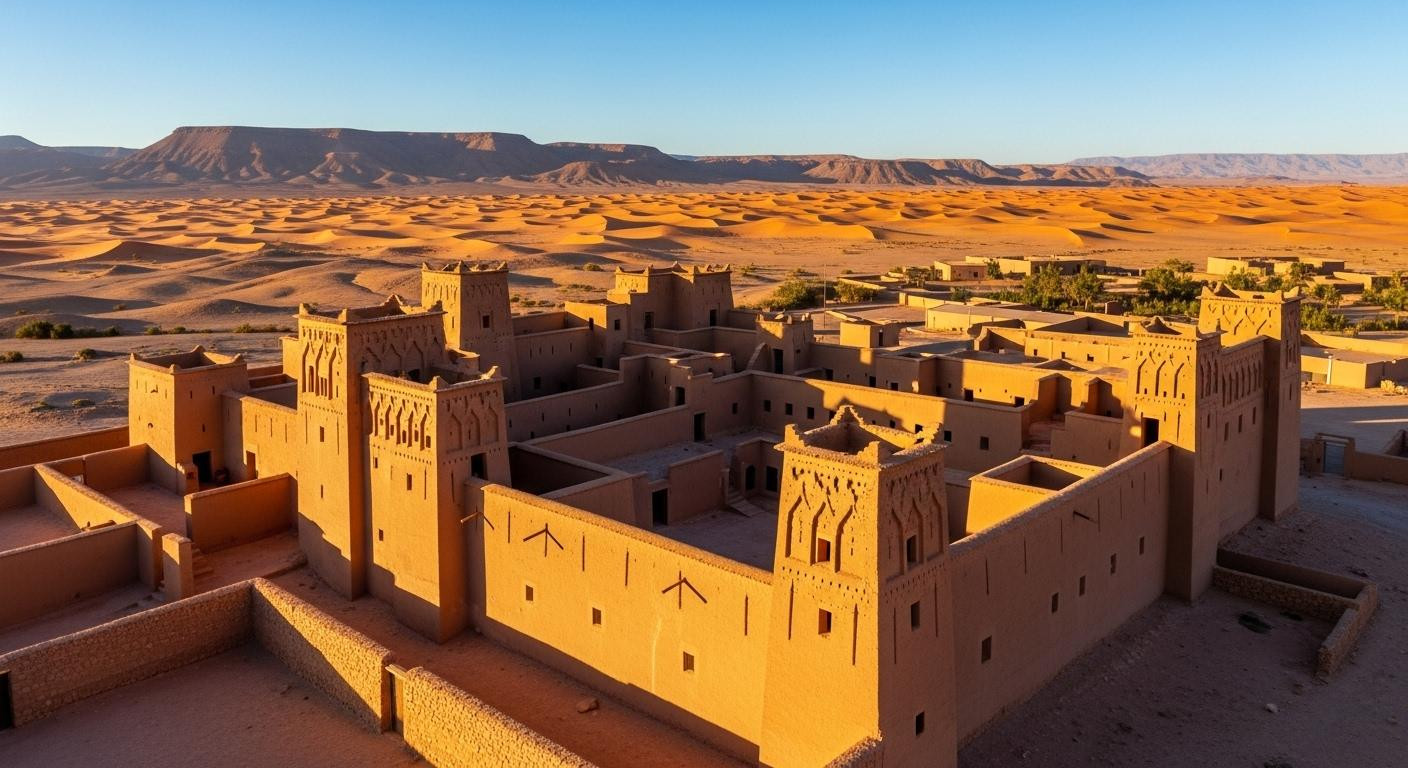At 6:47 AM in southern Tunisia, golden light touches 400 vaulted storage rooms stacked four stories high. Steam rises from mint tea in courtyards unchanged since 1699. This is Ksar Ouled Soltane, where 15th-century Berber architecture meets Star Wars mythology at half the cost of Morocco’s famous kasbahs.
No tour buses clog the narrow road 14 miles southeast of Tataouine. No aggressive vendors hawk trinkets in the dual courtyards where Anakin Skywalker’s slave quarters were filmed. Just weathered adobe walls glowing amber in desert light, and admission for $5.20.
The vertical fortress that time preserved
Ksar Ouled Soltane rises from a hilltop at 1,050 feet elevation like a mirage made solid. Two massive courtyards stretch 197 by 131 feet each, surrounded by barrel-vaulted storage rooms called ghorfas. The western courtyard dates to 1699, built by the Berber Ouled Soltane tribe who migrated from Libya.
The eastern expansion came in the mid-19th century, bringing the total to approximately 400 individual storage chambers. Each ghorfa accessed by steep stone staircases zigzagging up four-story facades. Wooden hooks still hang from doorways where grain bags were hoisted centuries ago.
Unlike Morocco’s often-reconstructed kasbahs, the 1997 restoration preserved 78% of the original mud-brick structure. Only essential cement reinforcement was added to upper levels. This authentic construction creates the geometric drama that caught filmmaker attention in the late 1990s.
What 400 vaulted rooms reveal about desert engineering
Architecture that defies gravity and heat
Barrel vaults span 9-10 feet without modern support during construction. Adobe bricks laid in concentric circles create cooling chambers where interior temperatures stay 64-75°F year-round. Exterior temperatures range from 32-122°F across seasons.
Thick earthen walls absorb higher sound frequencies while enhancing lower tones. The result: a uniquely calming acoustic environment that amplifies whispers while muffling harsh desert winds. Each courtyard functions as a natural amphitheater.
From grain fortress to galactic cinema
For five centuries, nomadic families stored harvests here during seasonal migrations. Friday afternoons brought community gatherings when shepherds returned with flocks. The tradition continues today, though tourism has replaced agriculture as the primary economy.
Star Wars Episode I filmed slave quarters scenes in the eastern courtyard during September-October 1997. Unlike other Tunisian film locations, minimal set modifications were required. The otherworldly architecture needed no Hollywood enhancement.
The Morocco experience at half the price
What $5.20 admission delivers
Unrestricted photography access beats Morocco’s tripod restrictions. Four-story climbing freedom offers panoramic desert views. Golden hour transforms mud walls into amber-rose spectacles from 4:45-5:15 PM daily.
Guided tours cost $9.75 versus $14.30 at Aït Benhaddou. Tataouine accommodation runs $45-75 nightly compared to Marrakech’s $95-165. Car rental from nearby Gabès: $35-55 daily versus Marrakech’s $50-80. Traditional meals: $4-7 versus Morocco’s $8-14.
Beyond the ksar: Tunisia’s desert circuit
Chenini’s hilltop Berber village sits 9 miles away ($2.60 entry). Douiret’s abandoned ksar requires no admission 14 miles southeast. Matmata’s troglodyte homes (75 miles north, $3.25 entry) complete the circuit. Total costs: $30.55 for southern Tunisia’s heritage triangle versus Morocco’s $68.50 equivalent.
Recent visitor surveys show 92% satisfaction rates. Many travelers report preferring Tunisia’s unhurried pace to Morocco’s tourist intensity.
When desert light becomes architecture
November mornings reveal why photographers arrive at dawn. Temperatures drop to 46-54°F overnight, rising to comfortable 72-79°F by afternoon. Shadows in courtyard canyons create geometric drama impossible to capture elsewhere.
Annual visitors total 91,200 compared to Aït Benhaddou’s 750,000. Daily averages: 120 visitors in winter, 220 during shoulder seasons, 450 in peak summer. The silence at sunrise feels like discovering Petra before Instagram existed.
Wild thyme grows between weathered stones. Sun-warmed adobe releases earthy scents mixed with distant calls to prayer from Tataouine. Wind through 400 ghorfa doorways creates natural music unchanged since the 15th century.
Your questions about Ksar Ouled Soltane answered
How do I reach this desert fortress without tours?
Rent cars in Gabès (75 miles, 2 hours) or Djerba (94 miles, 2.5 hours). No public transport reaches the ksar directly. Taxis from Tataouine cost $9.75 round trip. US and European licenses are valid. Drive time from Tunis: 6-7 hours on well-maintained highways.
What makes this different from Moroccan kasbahs?
Authentic 15th-century mud-brick construction versus reconstructions. Zero aggressive vendors or commercialization. Entry costs 20% less with 85% fewer crowds than Aït Benhaddou. Star Wars filming adds modern appeal without theme park elements.
Can I stay overnight near the fortress?
Tataouine offers mid-range hotels for $45-75 nightly at Hotel Sahara Palace. No accommodation exists within the ksar itself as it remains a heritage site. Spring and fall provide optimal weather for desert camping with proper permits.
At 5:47 PM, amber light ignites weathered walls four stories high. Shadows deepen in vaulted doorways unchanged since Berber nomads first stored grain here. Below, the Sahara stretches golden toward Libya. This is Tunisia’s secret: 400 rooms guarding silence more precious than grain, at half what Morocco charges for the same desert dreams.
